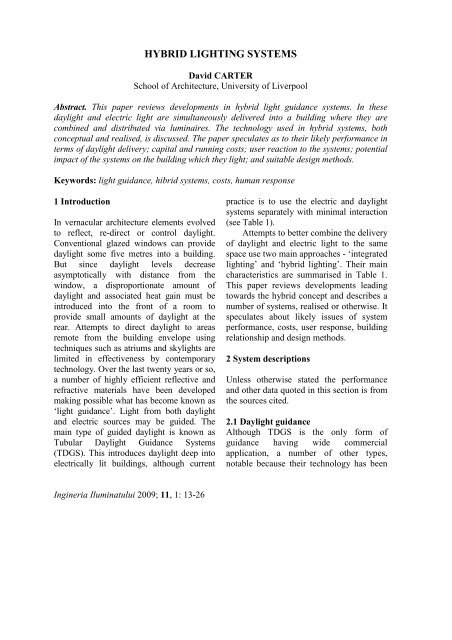ingineria iluminatului - Journal of Lighting Engineering - Prof. Florin ...
ingineria iluminatului - Journal of Lighting Engineering - Prof. Florin ...
ingineria iluminatului - Journal of Lighting Engineering - Prof. Florin ...
You also want an ePaper? Increase the reach of your titles
YUMPU automatically turns print PDFs into web optimized ePapers that Google loves.
Ingineria Iluminatului 2009; 11, 1: 13-26<br />
HYBRID LIGHTING SYSTEMS<br />
David CARTER<br />
School <strong>of</strong> Architecture, University <strong>of</strong> Liverpool<br />
Abstract. This paper reviews developments in hybrid light guidance systems. In these<br />
daylight and electric light are simultaneously delivered into a building where they are<br />
combined and distributed via luminaires. The technology used in hybrid systems, both<br />
conceptual and realised, is discussed. The paper speculates as to their likely performance in<br />
terms <strong>of</strong> daylight delivery; capital and running costs; user reaction to the systems; potential<br />
impact <strong>of</strong> the systems on the building which they light; and suitable design methods.<br />
Keywords: light guidance, hibrid systems, costs, human response<br />
1 Introduction<br />
In vernacular architecture elements evolved<br />
to reflect, re-direct or control daylight.<br />
Conventional glazed windows can provide<br />
daylight some five metres into a building.<br />
But since daylight levels decrease<br />
asymptotically with distance from the<br />
window, a disproportionate amount <strong>of</strong><br />
daylight and associated heat gain must be<br />
introduced into the front <strong>of</strong> a room to<br />
provide small amounts <strong>of</strong> daylight at the<br />
rear. Attempts to direct daylight to areas<br />
remote from the building envelope using<br />
techniques such as atriums and skylights are<br />
limited in effectiveness by contemporary<br />
technology. Over the last twenty years or so,<br />
a number <strong>of</strong> highly efficient reflective and<br />
refractive materials have been developed<br />
making possible what has become known as<br />
‘light guidance’. Light from both daylight<br />
and electric sources may be guided. The<br />
main type <strong>of</strong> guided daylight is known as<br />
Tubular Daylight Guidance Systems<br />
(TDGS). This introduces daylight deep into<br />
electrically lit buildings, although current<br />
practice is to use the electric and daylight<br />
systems separately with minimal interaction<br />
(see Table 1).<br />
Attempts to better combine the delivery<br />
<strong>of</strong> daylight and electric light to the same<br />
space use two main approaches - ‘integrated<br />
lighting’ and ‘hybrid lighting’. Their main<br />
characteristics are summarised in Table 1.<br />
This paper reviews developments leading<br />
towards the hybrid concept and describes a<br />
number <strong>of</strong> systems, realised or otherwise. It<br />
speculates about likely issues <strong>of</strong> system<br />
performance, costs, user response, building<br />
relationship and design methods.<br />
2 System descriptions<br />
Unless otherwise stated the performance<br />
and other data quoted in this section is from<br />
the sources cited.<br />
2.1 Daylight guidance<br />
Although TDGS is the only form <strong>of</strong><br />
guidance having wide commercial<br />
application, a number <strong>of</strong> other types,<br />
notable because their technology has been
















